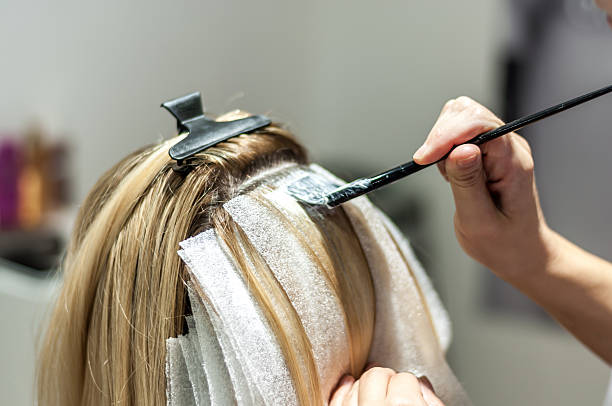Understanding Tiger Stripe Highlights
Definition and Causes of Tiger Stripes
Tiger stripe highlights are characterized by their contrasting stripes of color that stand out too boldly from the base hair color. This could occur due to uneven application of bleach or color, too-thick sections during highlighting, or using caps or foils improperly. Recognizing the causes of tiger stripes is the first step towards correcting them and will help prevent the same mistake in the future.
Evaluating the Severity of Your Tiger Stripes
Identifying the severity is crucial. Are the stripes significantly lighter than your base color, or just a bit off? This assessment will determine the extent of the corrective measures you will need to take. Mild cases might not need as much intervention as more pronounced stripes, which will need a more thorough approach.
| Severity Level | Description | Recommended Action |
|---|---|---|
| Low | Subtle tiger stripes, barely noticeable. | Use a gentle clarifying shampoo to gradually fade the stripes. |
| Medium | Prominent tiger stripes, noticeable under certain lighting. | Apply a toner or gloss to blend the highlights with the base color. |
| High | Obvious and harsh tiger stripes, significantly different from base color. | Seek professional help from a hair colorist to correct the stripes. |

Preparing for the Correction Process
Assembling Your Tools and Materials
Before beginning the correction process, gather all the materials you will need. This includes:
- Color corrector or a dye that closely matches your base hair color
- Applicator brush
- Mixing bowl
- Gloves
- Timer
- Hair clips for sectioning
- Foils (optional, for precision)
Having everything on hand will help streamline the process and prevent any unnecessary mid-procedure scrambling that could cause additional stresses to your hair.
Conducting a Strand Test
It’s important to conduct a strand test before you apply any product to your entire head. A strand test involves applying the color to a small, discreet section of hair to predict the outcome. This can help you avoid further mistakes and understand how your hair will react to the correction treatment.
Sectioning Your Hair for Easy Application
Before the actual application, you will need to carefully section your hair. This could also prevent tiger stripes by ensuring an even application of the corrective color. Divide your hair into four quadrants by parting down the middle and then from ear to ear. Secure each section with hair clips.
Step-by-Step Process to Repair Tiger Stripes
Color Selection and Mixing
Choose a color that blends with your original hair color. The goal is to color-correct the highlights so they do not stand out starkly. Once you’ve chosen the right shade, mix your dye according to the product instructions in a mixing bowl. Wearing gloves, stir the mixture until it is smooth and consistent.
Applying Color to Diminish Stripes
Now, the application process plays a critical role in effectively removing tiger stripes. Work with one section at a time, applying the color to the stripe highlights. Be meticulous to avoid overlapping excessively onto the hair parts that do not require correction. Using foils will help isolate the highlighted sections and protect the surrounding hair.
Monitoring the Processing Time
After applying the dye, it is essential to monitor the time it stays in your hair. The strand test you conducted earlier will give you a good indication of how long you should leave the dye in. Timeliness is crucial; too short will not allow the color to deposit fully, while too long could also result in unwanted shades or further damage to your hair.

Post-Coloring Care and Maintenance
Washing and Conditioning Protocols
After successfully blending your tiger stripe highlights and achieving a more harmonious hair color, proper washing and conditioning are next on the agenda. Initially, it’s best to avoid washing your hair for 48 hours after the color treatment to allow the dye to settle. Once this period has passed, use lukewarm water, and opt for sulfate-free shampoos and conditioners specifically designed for color-treated hair. These products are gentler and will help preserve the longevity of your newly corrected hair color. Condition regularly to keep your hair nourished and hydrated, as this will help maintain the luster and even appearance of the color.
Products and Practices to Maintain Even Tones
To extend the life of your corrected highlights and enhance the health of your hair, consider incorporating leave-in treatments or hair masks into your regular routine. Products containing color-protecting ingredients like UV filters or antioxidants are particularly beneficial. To maintain even tones:
- Schedule regular trims to remove any split ends or damaged sections.
- Utilize a toning shampoo or conditioner once every few weeks to counteract any brassiness or color variation.
Adopting these practices will not only keep your hair looking stellar but will also help prevent the reappearance of tiger stripes in the future.
Alternative Solutions and Tips
When to Seek Professional Help
There are situations when home remedies will not fully resolve the issue with stripe highlights. If after your initial corrective attempt the tiger stripes are still prominent, or the hair has become overly processed and damaged, it’s time to consult a professional. Hairstylists are equipped with the expertise and products that can help repair color mishaps. They can also provide services like a color melt or balayage to seamlessly blend the highlights, which might not be feasible to execute at home.
Prevention Tips for Future Highlighting
To prevent tiger stripes in the future, consider these helpful tips when highlighting your hair:
- Always follow the instructions provided with the highlighting kit.
- Use fine sections of hair rather than large chunks to achieve a more diffused, natural look.
- Utilize a hand-painting technique like balayage for a softer growth line and fewer demarcations.
Keep in mind that practice makes perfect. Working gradually and carefully will also go a long way toward achieving the desired result without the unwanted stripes.

Conclusion
Repairing tiger stripe highlights at home requires patience, precision, and the right approach to color correction. By understanding the problem and taking systematic steps to blend the harsh lines, you can restore your hair’s color harmony. Post-treatment care is equally crucial in maintaining the health and color consistency of your locks. While home remedies can be effective, there’s no substitute for a professional’s touch in complex cases. Remember, prevention is key; applying highlights with careful consideration will help you dodge potential issues and keep your hair looking beautifully blended.
FAQs
How can I tell if I’ve successfully corrected my tiger stripe highlights?
You’ll know the tiger stripes have been corrected when the once-prominent lines of demarcation blend seamlessly into your base color. Your hair should appear more uniform in color, with highlights that look natural and intentional.
Will fixing tiger stripe highlights damage my hair?
While any chemical process can potentially damage hair, using a color-correction method that includes nourishing and conditioning treatments can minimize harm. Following product instructions and not over-processing are key factors in avoiding damage.
How long should I wait before attempting to fix tiger stripes at home?
It’s recommended to wait at least a week after your initial highlighting treatment to allow your hair to rest and recuperate before attempting any color correction.
What is the biggest mistake people make when trying to fix tiger stripes at home?
The biggest mistake is rushing the process and not sectioning the hair properly, which can lead to uneven color application or further visible lines of demarcation.
Are there specific hair types that are more prone to developing tiger stripe highlights?
Tiger stripes are not necessarily dependent on hair type but are more related to the highlighting technique and application process. However, those with very thick or curly hair might find it more challenging to achieve an even application without professional help.



